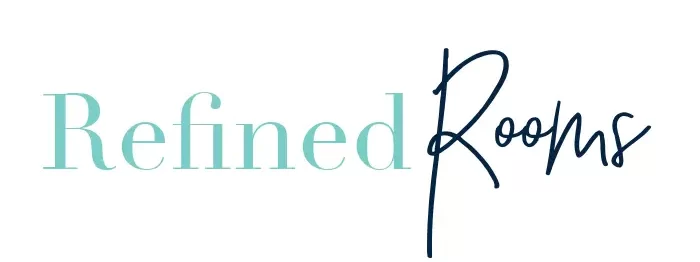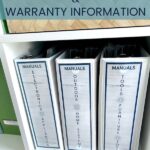Don’t let product manuals eat up valuable space in your file cabinet! Use this tried and True method for organizing product manuals and warranties that makes them easy to access whenever you need them.
Did you know that paper management is the number one reason that people hire a professional organizer?
Despite our best efforts to “go paperless“, it has certainly been my experience that paper clutter is a universal challenge, and reducing paper clutter is a common goal for my clients
That’s why paper organization and management is a hot topic on the blog!
Today, we’re going to hone in on a very specific form of paper management: organizing all of the reference paperwork that’s associated product purchases.
Product manuals, warranties, and receipts for big-ticket items are a super common source of paper clutter that I come across in client’s homes.
I have a favorite method for corralling all of these when on the job. But ironically, I’ve never taken the time to organize my own collection of manuals!
Ever hear that saying about the cobbler’s children who have no shoes? Sometimes this holds true for pro organizers too!

Organizing Product Manuals and Warranties: My Tried and True Method
Product manuals were taking up an entire drawer in my filing cabinet. As part of my recent file cabinet overhaul, my goal was to free up the filing cabinet drawer for storing business-related files.
Related: Reference File Organization
As you might have guessed, the first step in the process is to gather all the paper into a central location and begin sorting into categories.
I suggest that you set aside papers for home improvement purchases (i.e., carpeting, plumbing fixtures) and large appliances. These papers should be placed in a separate binder to be given to the new homeowner in the event that you sell your home (this step also makes it easy to enter this information into your home inventory).
That leaves you with only the papers for items that would go with you in the event of a move.
Depending upon your consumer tendencies, your piles may look something like this:

During the sorting process, have the recycle bin close at hand, as you will invariably come across manuals and warranties for items you no longer own, especially if it’s been a few years since you’ve gone through these files:

This post contains affiliate links for your shopping convenience (which means if you make a purchase after clicking a link I will earn a small commission, but it won’t cost you a penny more)! Click here to read my full disclosure policy.
My preferred method for containing all of these papers is to create 3-ring binders combined with poly binder pockets with Velcro closures for each category of products.
Binder pockets work great for this purpose, and can typically accommodate up to 200 pages per pocket.
Post It stick-on filing tabs are perfect for labeling the product categories contained within each binder pocket.
Take a peek at what a binder looks like when fully assembled:

Related: Organizing With Binders: Managing Household Papers and Projects.
One binder is rarely sufficient for the average household with kids. In fact, our papers required a total of four binders to contain all of our product manual/warranty information (the three binders for “portable” products below, as well as our binder for items that will stay with the house when we move).
The final step is to create a cover sheet and a spine insert for the binder that summarizes the product categories contained within each binder:

Where to Find Product Manuals Online
Of course, for those who are on the “paperless” bandwagon, you can bypass this whole process by searching for the PDF versions of the product manuals online.
Most manufacturers make product manuals available electronically now. BT.com offers a comprehensive list of online resources for locating just about any product manual you might be searching for.
That’s it in a nutshell — my tried and true method for organizing manuals and warranties!
Going to give it a try?
Take a pic of your binder(s) and tag me over on Instagram (@refined_rooms). I’d love to celebrate with you!
Need More Paper Organizing Tips?




- Printables for Organizing Home & Life: The ULTIMATE Organizing Printables Vault! - November 28, 2023
- Clipboard Wall Organization for Papers: Easy DIY Paper Storage! - September 4, 2023
- How to Plan a Graduation Party to Remember: The Ultimate Graduation Party Planner - May 9, 2023


Janet Barclay says
Your suggestion to store paperwork for stuff you’ll take if you move separately from stuff that will stay behind is brilliant! It’s a real pain to have to sort all that out when you’re busy getting ready to move!
Dave says
Thanks for presenting your way of organizing manuals! My experience is that this approach works fine when the manuals are larger (A5 or A4 size). But with small, thick manuals the folders quickly develop bulges and due to the manuals’ weight everything gathers in one corner. So I’ll continue looking for a solution that fits for many small, thick manuals as well.
Natalie Gallagher says
Yes Dave, there are many ways to organize manuals, but the best way is to purge as many as you can and go digital 🙂
In your case (with many small manuals), another method I would recommend is to set up a system comprised of file box with hanging files. Best of luck!
Peter Nelson says
You must have very thin manuals. Granted, I have lots of manuals, for things like kitchen appliances or garage tools that are just a few pages. But I also have manuals for professional photo, video, audio, or studio equipment that are over 500 pages long. Also sometimes this latter sort of gear has accessories such as lenses, power-packs, etc, which have their own manuals and it would be nice to keep them together.
Yvonne says
What does your binder look like for things that stay with the home? I am trying to organize these things, because our house closes escrow next week.
Natalie Gallagher says
Hi Yvonne! Sorry for the late response to your question. My binder is divided up into the following sections: 1. Home Purchase documents 2. Home Improvements (a running list of the updates/improvements we’ve completed since the purchase — including date of improvement, detailed description, vendors used, and receipts). 3. Homeowner’s Association information 4. Manuals for appliances/HVAC etc. (anything that would stay with the home if we move).
Hope that helps!
Amy says
thanks. what about all the extra pieces/parts that come with fixtures? those will not fit well in a binder and will tear the plastic protectors….
Natalie Gallagher says
Yes, I agree. They don’t belong in the binders. I store those separately in a small bin that’s located in the basement storage room. Then I place a Post It note on the manual that reminds me where I stored these parts 🙂